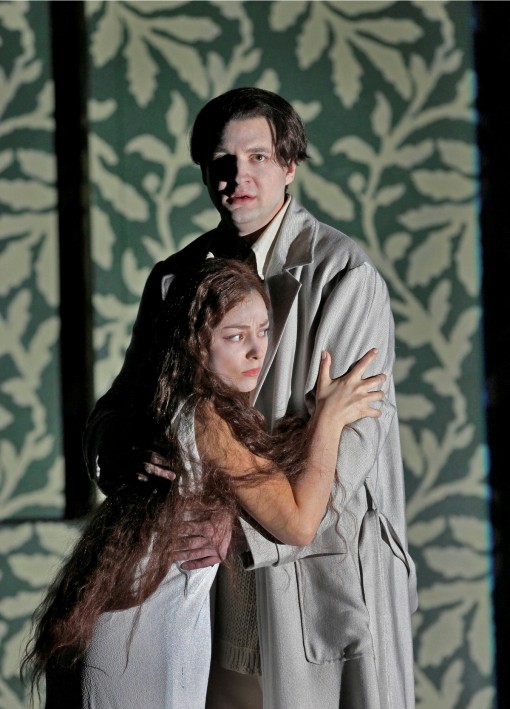A probing and insightful “Pelleas” in St. Louis

Corinne Winters and Liam Bonner in "Pelleas et Melisande" at Opera Theatre of St. Louis. Photo: Ken Howard.
John Adams’s The Death of Klinghoffer is not the only slow-moving opera to score a success at Opera Theatre of Saint Louis this summer. Pelléas and Mélisande, which can be one of the most challenging sits your average operagoer regularly undergoes, proved arresting in a production by David Alden that found the provocative director in probing form and venturing forth not a single half-baked or frivolous idea.
Preliminarily, it must be said that the production benefited significantly from OTSL’s English-language policy and in particular from Hugh Macdonald’s lucid translation. Debussy’s unassuming style of text setting promotes maximum intelligibility, whether sung in the original French or in translation, and hearing the opera in English made for a special sense of immediacy with the drama—always a goal of opera in the vernacular but one rarely attained.
Alden’s direction also helped one get closer to the characters than we’re used to, yet their stylized movements often reinforced the opera’s sense of mystery. After Pelléas and Mélisande finally acknowledge their mutual love in words, the jealous Golaud is seen ritualistically encircling them, gradually getting close enough to kill his half-brother Pelléas.
As with Jonathan Miller’s production for the Metropolitan Opera, the action takes place within the elderly king Arkel’s palace. Yet Paul Steinberg’s simple décor, which like many an Alden production is dominated by wallpaper with a passé design, facilitates transition from indoor and outdoor scenes.
The clarity of Alden’s direction often brings out points, sensitively underscored by Adam Silverman’s lighting, that may seem obvious yet are often obscured in performance. For instance, at the beginning of Act 4, when we learn that the health of Pelléas’s (unseen) father has taken a turn for the better, Arkel interprets this as a sign that the palace will become a happier place.
The sympathetic performance by the veteran John Cheek, in steady voice, is especially valuable here. He leads family members to a nicely set dinner table. But events turn in the opposite direction from what Arkel hopes for after Golaud enters and begins abusing Mélisande.
The boy Yniold, Golaud’s son by first wife, takes an unusually active role, especially in the final scene when he physically shields the dying Mélisande from possible violence by Golaud and later takes custody of her newborn baby.
The cast had not a weak link. Corinne Winters, singing with a darkish, creamy soprano, projected both Mélisande’s enigmatic and her endearing sides. Liam Bonner, a baritone Pélleas, displayed a muscular voice of considerable power yet consistently applied it toward expressive ends. Gregory Dahl’s appealingly lyrical baritone emphasized Golaud’s inner turmoil over his villainy. Maria Zifchak did well as Geneviève, and the boy soprano Michael Kepler Meo (Charlie in last summer’s The Golden Ticket) was a splendid Yniold.
Conductor Stephen Lord was by no means impervious to score’s nuance and color, but his chief contribution was to give the music a rhythmic underpinning that underscored and propelled the drama onstage.
——–
Don Giovanni, staged jointly by James Robinson and Michael Shell, looked like an attempt to do Mozart’s opera on the cheap. You could sense a collective letdown from the audience when the curtain went up on a gray and pastel blue urban scene (complements of Bruno Schwengl, who also designed the costumes) that looked more like a sketch for a set than a finished product. A plastic drop curtain bearing Mozart’s autograph facilitated quick scene changes.
Somebody had the idea of having several ghostly figures appear at key points. If they were supposed to be ghosts of Giovanni’s victims, their ages suggested his activities went on for some time. And there were men among the figures, who never made it into Leporello’s catalogue. But maybe they were supposed to be the victims’ fathers or lovers.
At least there was some intermittently enjoyable singing. Maria Kanyova brought a strong voice and fiery temperament, as well as some faulty intonation, to Donna Anna, and Kishani Jayasinghe sang Donna Elviva with a soprano of lovely quality even if she hadn’t completely mastered the intricacies of Mi tradì. Kathryn Leemhuis was an unremarkable Zerlina.
Elliot Madore contributed an engagingly energetic and resonantly sung portrayal of the celebrated lover, though he lacked honeyed soft singing for the Serenade. Levi Hernandez was a nimble Leporello with a comic streak. David Portillo’s unusually virile Don Ottavio was sung of liquid tone; he should have been allowed Dalla sua pace. Ably completing the cast were Andrew Gangestad and Bradley Smoak as the Commendatore and Masetto.
Conductor Jane Glover’s impeccable early-music credentials translated into a performance with crisp and light textures, but one wanted more bite and sheer volume at big moments like the first two chords.
Posted Jul 01, 2011 at 5:45 pm by Jane Milligan
Apparently Mr. Loomis and I attended two different productions of Don Giovanni. Kathryn Leemhuis definitely had the strongest, unforced, voice among the 3 female leads during the performance I attended. (Does Mr. Loomis understand that singers’ voices should never sound “forced”? If the voice is forced, something is wrong with the performer’s technique.) Ms. Leemhuis’s arias were delivered with great tenderness and emotion, neither of which were “forced.” Her performance was quite natural and touching. I suggest Mr. Loomis attend more than one performance to appreciate the bigger picture!